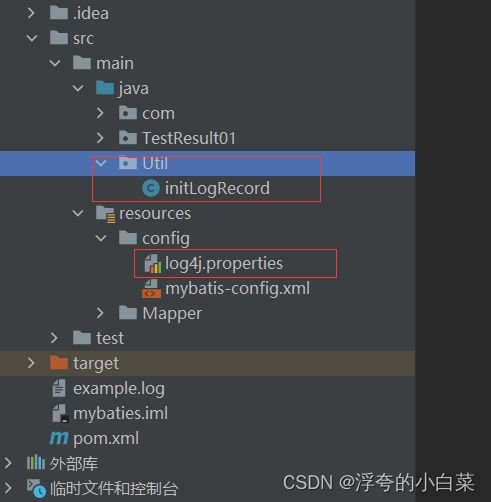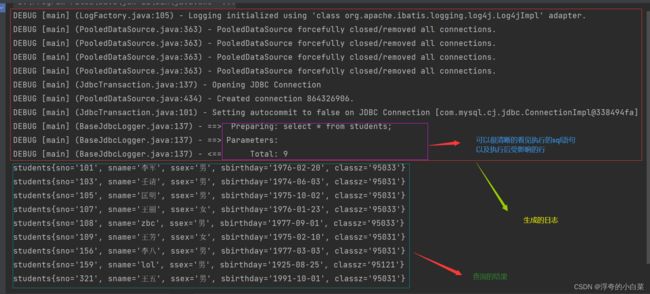- How Spark Read Sftp Files from Hadoop SFTP FileSystem
IT•轩辕
CloudyComputationsparkhadoop大数据
GradleDependenciesimplementation('org.apache.spark:spark-sql_2.13:3.5.3'){excludegroup:"org.apache.logging.log4j",module:"log4j-slf4j2-impl"}implementation('org.apache.hadoop:hadoop-common:3.3.4'){exc
- CVE-2017-5645(使用 docker 搭建)
JM丫
网络安全
介绍:是一个与ApacheLog4j2相关的安全漏洞,属于远程代码执行,它可能允许攻击者通过构造恶意的日志信息在目标系统上执行任意代码Log4j2介绍Log4j2是Apache的一个日志记录工具,属于Java应用的日志框架,它是Log4j的升级版,性能更好,功能更多.它被广泛的适用于Java应用程序中,帮助开发者记录程序运行的时候的日子信息,是Java生态系统中最重要的一个日志框架之一漏洞编号:C
- SpringBoot使用@Slf4j注解实现日志输出
pan_junbiao
SpringBoot我の原创springbootjavaspring
日志框架的使用,系列文章:《SpringBoot使用Logback日志框架与综合实例》《SpringBoot使用@Slf4j注解实现日志输出》《Log4j2日志记录框架的使用教程与简单实例》《SpringBoot使用AspectJ实现AOP记录接口:请求日志、响应日志、异常日志》《SpringBoot使用AspectJ的@Around注解实现AOP全局记录接口:请求日志、响应日志、异常日志》@Sl
- slf4j导入那个依赖_复杂Spring项目中SLF4J最佳使用姿势
weixin_39955421
slf4j导入那个依赖
一、Java日志体系概述图1-1Java日志体系概况图1-1展示了Java日志体系的三个主要部分:日志门面接口(SLF4J、JCL)一系列绑定和桥接具体的日志实现先来两个例子:Spring项目中通过CommonsLogging直接使用log4j图1-2通过CommonsLogging使用log4j本例中由于spring-core中原生依赖commons-logging,所以只需要添加log4j和l
- log4j2 滚动删除日志文件(最后访问时间&大小)
log4j2日志
有时我们需要滚动删除日志,不然日志会越积越多。从log4j22.5之后,在日志滚动的时候可以自定义删除操作,比如我们希望保留3天的日志,可以这么配置:-name:FileAppenderfileName:/tmp/log/test.logfilePattern:/tmp/log/test.log.%d{yyyy-MM-dd}"PatternLayout:pattern:%-d{yyyy-MM-dd
- MyBatis使用log4j打印日志相关配置
劲雨波
MyBatismavenjavaintellij-idealog4jmybatis
目录一、环境二、依赖三、配置1、log4j.properties2、配置信息一、环境maven:3.6.3ideal:2020MyBatis:3.5.4二、依赖org.slf4jslf4j-log4j121.7.5三、配置1、log4j.properties在resources中新建log4j.properties2、配置信息在log4j.properties中输入以下信息log4j.rootLo
- Java连接Zookeeper,创建监听通知机制
永旗狍子
SpringLinuxzookeeperjava
目录一.Java连接Zookeeper1.创建Springboot工程,导入依赖1.1排除log4j和桥接包2.配置application.yml3.编写连接Zookeeper的工具类4.监听通知机制4.1在zookeeper容器内部新增节点一.Java连接Zookeeper1.创建Springboot工程,导入依赖org.springframework.bootspring-boot-start
- 跨平台 日志库 log4cpp :使用指南
恋恋西风
C/C++java前端开发语言
1.log4cpp日志介绍log4cplus是一个灵活的日志库,不仅仅可以跨平台,功能强大,受到了Java的log4j库的启发,并为C++设计。它提供了丰富的日志级别、日志格式和输出目标的配置选项,使得开发者能够根据应用程序的需要灵活地记录信息。2.特点灵活性:log4cplus提供了多种日志级别和输出选项,支持异步和同步日志记录。易用性:它的API简单直观,易于集成到现有项目中。可配置性:可以通
- java 批量查询es_java操作ES的简单查询和bool查询
weixin_39831567
java批量查询es
导入包org.elasticsearch.clienttransport5.2.2org.apache.logging.log4jlog4j-api2.7org.apache.logging.log4jlog4j-core2.7junitjunitRELEASEViewCode2.Java操作基本操作通过client客户端对象获得客户端然后通过preparIndex等方法传入index,type,
- 黑马头条项目微服务启动时控制台给出警告信息SLF4J Class path contains multiple SLF4J bindings
聂 可 以
JavaSpringBoot黑马头条javaspringboot微服务
文章目录1.错误呈现2.错误产生的原因3.解决办法(可应用于其它微服务)3.1排除Log4j2的依赖3.2引入Logback的依赖3.3重启项目视频教程:Day1-12-app端登录-功能实现1.错误呈现SLF4J:ClasspathcontainsmultipleSLF4Jbindings.SLF4J:Foundbindingin[jar:file:/F:/MavenRepository/ch/
- 如何判断系统是否使用 Log4j,并检测漏洞的存在?
Aishenyanying33
log4j
前言Log4j的漏洞(Log4Shell)是近年来网络安全领域非常严重的问题,它的影响范围极广。为了保护系统安全,我们需要判断自己的系统是否使用了Log4j,以及是否存在相关漏洞。本文将详细介绍如何检测Log4j的使用,并通过输入测试字符串的方式来判断漏洞是否存在。1.如何判断系统是否使用了Log4j?方法1:检查系统代码或依赖查看代码库:在代码中搜索是否引用了Log4j,特别是类似org.apa
- Spring Boot 整合 log4j2 日志配置教程
m0_74823317
面试学习路线阿里巴巴springbootlog4j单元测试
文章目录前言一、常用日志框架二、配置参数介绍1.日志级别2.输出形式3.日志格式3.1PatternLayout自定义日志布局三、Log4j2配置详解1.根节点Configuration2.Appenders节点2.1Console节点2.2File节点2.3RollingFile节点2.3.1ThresholdFilter节点2.3.2Policies节点2.3.3ThresholdFilter
- SpringBoot使用logback日志框架超详细教程
2301_81937891
springbootlogback单元测试
前言项目中日志系统是必不可少的,目前比较流行的日志框架有log4j、logback等,可能大家还不知道,这两个框架的作者是同一个人,Logback旨在作为流行的log4j项目的后续版本,从而恢复log4j离开的位置。另外slf4j(SimpleLoggingFacadeforJava)则是一个日志门面框架,提供了日志系统中常用的接口,logback和log4j则对slf4j进行了实现。我们本文将讲
- SpringCloud/Boot集成LogBack
azoon.top
springcloudlogbackspringlog4jslf4j
一.简要介绍什么是SLF4J?官网介绍:SimpleLoggingFacadeforJava(SLF4J)充当简单的各种日志记录框架的Facade或抽象(e.g.java.util.logging、logback、log4j)允许最终用户在部署时插入所需的日志记录框架。类似java中的接口,如果只集成SLF4J,日志只能输出在控制台,并没有输出到文件的能力,要实现真正的日志能力,需要引入其实现层:
- [ vulhub漏洞复现篇 ] Apche log4j远程代码执行漏洞(CVE-2021-44228)
_PowerShell
[靶场实战]vulhubCVE-2021-44228远程代码执行漏洞Apchelog4j渗透测试
博主介绍博主介绍:大家好,我是_PowerShell,很高兴认识大家~✨主攻领域:【渗透领域】【数据通信】【通讯安全】【web安全】【面试分析】点赞➕评论➕收藏==养成习惯(一键三连)欢迎关注一起学习一起讨论⭐️一起进步文末有彩蛋作者水平有限,欢迎各位大佬指点,相互学习进步!文章目录博主介绍一、漏洞编号二、影响版本三、漏洞描述四、环境搭建1.进入CVE-2021-44228环境2.启动CVE-2
- 网络安全-系统层攻击流程及防御措施
星河776(重名区分)
网络安全web安全安全
系统层攻击流程涉及多个阶段,攻击者通过逐步渗透以获取控制权或窃取数据。以下是详细的流程及防御措施:1.侦察(Reconnaissance)信息收集:主动扫描:使用工具如Nmap、Masscan扫描目标IP、开放端口、服务版本。被动侦察:通过公开资源(Shodan、Censys)或DNS记录获取系统信息。漏洞匹配:比对CVE、Exploit-DB等数据库,寻找已知漏洞(如ApacheLog4j漏洞)
- Spark提交任务
docsz
sparkspark大数据
1、Spark提交任务到Yarn1.1、DwKuduAppspark-submit--classcom.io.etl.dwkudu.DwKuduApp\--files/etl/etl-dwkudu/conf/doris.property,/etl/etl-dwkudu/conf/redis.property,/etl/etl-dwkudu/conf/log4j.property\--mastery
- Spring Boot 中的日志管理
珠峰日记
springbootjava后端
一、日志框架选择1.主流框架对比框架特点SpringBoot默认支持Logback-性能优异,SpringBoot默认集成-支持自动热更新配置文件✅(默认)Log4j2-异步日志性能更强-支持插件扩展-防范漏洞能力更好❌(需手动配置)JUL(JDK自带)-无需额外依赖-功能简单,性能较差❌2.切换日志框架切换为Log4j2:org.springframework.bootspring-boot-s
- Apache Log4j2 远程代码执行漏洞复现
2ha0yuk7on.
apache安全web安全log4j2
0x01漏洞概述Log4j-2中存在JNDI注入漏洞,当程序将用户输入的数据被日志记录时,即可触发此漏洞,此次漏洞是用于Log4j2提供的lookup功能造成的,该功能允许开发者通过一些协议去读取相应环境中的配置。但并未对输入进行严格的判断,从而造成攻击者可以在目标服务器上执行任意代码。0x02漏洞复现环境搭建,引入log4j相关jar包,我这里使用的版本是2.14.1编写调用Log4j的方法,即
- 多个文件压缩成一个zip包
敲键盘的小猴子
Java基础java开发语言后端
importorg.apache.log4j.Logger;importjava.io.BufferedInputStream;importjava.io.File;importjava.io.FileInputStream;importjava.io.FileOutputStream;importjava.util.List;importjava.util.zip.CRC32;importjav
- Log4j
言慢行善
log4j
为什么使用日志框架:Log4j是Apache开发,现已到了Log4j2.x版本在Java程序中记录日志,帮助开发者在运行时追踪信息、警告、错误等内容可以控制每一条日志的输出格式通过一个配置文件,而不需要改应用的代码实际场景:周六周日程序出错!周一上班查原因。若请求报错,直接现场重新发送?有的请求因业务原因,不能重复发送。那当时错误怎么查看?只能从开发者设置的日志文件中找原因了。导包+简单使用开发过
- Log4j在Spring项目中的应用与实践
t0_54program
log4jspringjava个人开发
在现代Java开发中,日志记录是不可或缺的一部分。它不仅帮助开发者调试和监控应用程序的运行状态,还能在出现问题时快速定位原因。今天,我们就来探讨如何在Spring项目中使用Log4j进行日志管理,并通过具体的实例来展示其强大的功能。一、Log4j简介Log4j是Apache提供的一个开源日志框架,广泛应用于Java项目中。它提供了灵活的日志记录方式,支持多种日志级别和输出格式。通过配置文件,开发者
- SpringBoot中Mybatis记录执行sql日志
钝挫力PROGRAMER
springbootmybatissql
MyBatis默认使用SLF4J作为日志门面,所以需要在项目中选择一个SLF4J兼容的日志实现,比如Logback,Log4j2等。以Logback为例,也是SpringBoot默认日志框架。添加日志依赖:确保pom.xml中包含Logback依赖(SpringBoot项目不用添加logback):ch.qos.logbacklogback-classic配置Logback:在src/main/r
- shrio反序列化分析
红队蓝军
java开发语言安全
shiro550环境搭建https://codeload.github.com/apache/shiro/zip/shiro-root-1.2.4配置pom.xmljavax.servletjstlruntimejavax.servletservlet-apiprovidedorg.slf4jslf4j-log4j12runtimelog4jlog4jruntimenet.sourceforge.
- SSM框架搭建
皇家大厨
笔记
此文参考书籍为ACCP软件工程师——使用SSM框架开发企业级应用8.0版文章目录遇到的问题:1.错误:couldnotfindresourcesrc/dao/UserMapper.xml和mybatis启动异常:Logginginitializedusing'classorg.apache.ibatis.logging.log4j.Log4jImpl'2.Eclipse中的路径问题:3.log4j
- Spring Boot 整合 log4j2 日志配置教程
m0_74824517
面试学习路线阿里巴巴springbootlog4j单元测试
文章目录前言一、常用日志框架二、配置参数介绍1.日志级别2.输出形式3.日志格式3.1PatternLayout自定义日志布局三、Log4j2配置详解1.根节点Configuration2.Appenders节点2.1Console节点2.2File节点2.3RollingFile节点2.3.1ThresholdFilter节点2.3.2Policies节点2.3.3ThresholdFilter
- Detected both log4j-over-slf4j.jar AND bound slf4j-log4j12.jar on the class jar包冲突解决
It_BeeCoder
000项目开发问题整理SpringCloudSpringBootjavaspringboot
问题描述今天在启动项目时遇到了以下问题:Detectedbothlog4j-over-slf4j.jarANDboundslf4j-log4j12.jarontheclass,经排查发现是由于日志引用冲入导致;解决方案
- Java实现日志全链路追踪.精确到一次请求的全部流程
王会举
javalog4j
广大程序员在排除线上问题时,会经常遇见各种BUG.处理这些BUG的时候日志就格外的重要.只有完善的日志才能快速有效的定位问题.为了提高BUG处理效率.我决定在日志上面优化.实现每次请求有统一的id.通过id能获取当前接口的全链路流程走向.实现效果如下:一次查询即可找到所有关键信息.不再被多线程日志进行困扰了.1:日志打印框架log4j->logbacklogback是springboot默认自带的
- 日志学习转载
ListerGray
Log
转载请看原文带你掌握Java各种日志框架文章目录一:日志基本概念及框架1:什么是日志2:日志的作用3:常用日志框架二:JUL日志框架1:框架结构图2:入门案例3:日志级别4:自定义日志(控制台记录和日志文件记录)5:JUL(Logging)父子关系6:JUL使用自定义配置文件三:Log4j日志框架1:入门案例2:日志级别3:Log4j相关组件(重点)4:自定义配置文件5:自定义配置Logger6:
- ES的java操作
天选之子123
大数据elasticsearchjava大数据
ES的java操作一、添加依赖在pom文件中添加依赖包org.elasticsearchelasticsearch7.8.0org.elasticsearch.clientelasticsearch-rest-high-level-client7.8.0org.apache.logging.log4jlog4j-api2.11.1org.apache.logging.log4jlog4j-core
- [黑洞与暗粒子]没有光的世界
comsci
无论是相对论还是其它现代物理学,都显然有个缺陷,那就是必须有光才能够计算
但是,我相信,在我们的世界和宇宙平面中,肯定存在没有光的世界....
那么,在没有光的世界,光子和其它粒子的规律无法被应用和考察,那么以光速为核心的
&nbs
- jQuery Lazy Load 图片延迟加载
aijuans
jquery
基于 jQuery 的图片延迟加载插件,在用户滚动页面到图片之后才进行加载。
对于有较多的图片的网页,使用图片延迟加载,能有效的提高页面加载速度。
版本:
jQuery v1.4.4+
jQuery Lazy Load v1.7.2
注意事项:
需要真正实现图片延迟加载,必须将真实图片地址写在 data-original 属性中。若 src
- 使用Jodd的优点
Kai_Ge
jodd
1. 简化和统一 controller ,抛弃 extends SimpleFormController ,统一使用 implements Controller 的方式。
2. 简化 JSP 页面的 bind, 不需要一个字段一个字段的绑定。
3. 对 bean 没有任何要求,可以使用任意的 bean 做为 formBean。
使用方法简介
- jpa Query转hibernate Query
120153216
Hibernate
public List<Map> getMapList(String hql,
Map map) {
org.hibernate.Query jpaQuery = entityManager.createQuery(hql);
if (null != map) {
for (String parameter : map.keySet()) {
jp
- Django_Python3添加MySQL/MariaDB支持
2002wmj
mariaDB
现状
首先,
[email protected] 中默认的引擎为 django.db.backends.mysql 。但是在Python3中如果这样写的话,会发现 django.db.backends.mysql 依赖 MySQLdb[5] ,而 MySQLdb 又不兼容 Python3 于是要找一种新的方式来继续使用MySQL。 MySQL官方的方案
首先据MySQL文档[3]说,自从MySQL
- 在SQLSERVER中查找消耗IO最多的SQL
357029540
SQL Server
返回做IO数目最多的50条语句以及它们的执行计划。
select top 50
(total_logical_reads/execution_count) as avg_logical_reads,
(total_logical_writes/execution_count) as avg_logical_writes,
(tot
- spring UnChecked 异常 官方定义!
7454103
spring
如果你接触过spring的 事物管理!那么你必须明白 spring的 非捕获异常! 即 unchecked 异常! 因为 spring 默认这类异常事物自动回滚!!
public static boolean isCheckedException(Throwable ex)
{
return !(ex instanceof RuntimeExcep
- mongoDB 入门指南、示例
adminjun
javamongodb操作
一、准备工作
1、 下载mongoDB
下载地址:http://www.mongodb.org/downloads
选择合适你的版本
相关文档:http://www.mongodb.org/display/DOCS/Tutorial
2、 安装mongoDB
A、 不解压模式:
将下载下来的mongoDB-xxx.zip打开,找到bin目录,运行mongod.exe就可以启动服务,默
- CUDA 5 Release Candidate Now Available
aijuans
CUDA
The CUDA 5 Release Candidate is now available at http://developer.nvidia.com/<wbr></wbr>cuda/cuda-pre-production. Now applicable to a broader set of algorithms, CUDA 5 has advanced fe
- Essential Studio for WinRT网格控件测评
Axiba
JavaScripthtml5
Essential Studio for WinRT界面控件包含了商业平板应用程序开发中所需的所有控件,如市场上运行速度最快的grid 和chart、地图、RDL报表查看器、丰富的文本查看器及图表等等。同时,该控件还包含了一组独特的库,用于从WinRT应用程序中生成Excel、Word以及PDF格式的文件。此文将对其另外一个强大的控件——网格控件进行专门的测评详述。
网格控件功能
1、
- java 获取windows系统安装的证书或证书链
bewithme
windows
有时需要获取windows系统安装的证书或证书链,比如说你要通过证书来创建java的密钥库 。
有关证书链的解释可以查看此处 。
public static void main(String[] args) {
SunMSCAPI providerMSCAPI = new SunMSCAPI();
S
- NoSQL数据库之Redis数据库管理(set类型和zset类型)
bijian1013
redis数据库NoSQL
4.sets类型
Set是集合,它是string类型的无序集合。set是通过hash table实现的,添加、删除和查找的复杂度都是O(1)。对集合我们可以取并集、交集、差集。通过这些操作我们可以实现sns中的好友推荐和blog的tag功能。
sadd:向名称为key的set中添加元
- 异常捕获何时用Exception,何时用Throwable
bingyingao
用Exception的情况
try {
//可能发生空指针、数组溢出等异常
} catch (Exception e) {
- 【Kafka四】Kakfa伪分布式安装
bit1129
kafka
在http://bit1129.iteye.com/blog/2174791一文中,实现了单Kafka服务器的安装,在Kafka中,每个Kafka服务器称为一个broker。本文简单介绍下,在单机环境下Kafka的伪分布式安装和测试验证 1. 安装步骤
Kafka伪分布式安装的思路跟Zookeeper的伪分布式安装思路完全一样,不过比Zookeeper稍微简单些(不
- Project Euler
bookjovi
haskell
Project Euler是个数学问题求解网站,网站设计的很有意思,有很多problem,在未提交正确答案前不能查看problem的overview,也不能查看关于problem的discussion thread,只能看到现在problem已经被多少人解决了,人数越多往往代表问题越容易。
看看problem 1吧:
Add all the natural num
- Java-Collections Framework学习与总结-ArrayDeque
BrokenDreams
Collections
表、栈和队列是三种基本的数据结构,前面总结的ArrayList和LinkedList可以作为任意一种数据结构来使用,当然由于实现方式的不同,操作的效率也会不同。
这篇要看一下java.util.ArrayDeque。从命名上看
- 读《研磨设计模式》-代码笔记-装饰模式-Decorator
bylijinnan
java设计模式
声明: 本文只为方便我个人查阅和理解,详细的分析以及源代码请移步 原作者的博客http://chjavach.iteye.com/
import java.io.BufferedOutputStream;
import java.io.DataOutputStream;
import java.io.FileOutputStream;
import java.io.Fi
- Maven学习(一)
chenyu19891124
Maven私服
学习一门技术和工具总得花费一段时间,5月底6月初自己学习了一些工具,maven+Hudson+nexus的搭建,对于maven以前只是听说,顺便再自己的电脑上搭建了一个maven环境,但是完全不了解maven这一强大的构建工具,还有ant也是一个构建工具,但ant就没有maven那么的简单方便,其实简单点说maven是一个运用命令行就能完成构建,测试,打包,发布一系列功
- [原创]JWFD工作流引擎设计----节点匹配搜索算法(用于初步解决条件异步汇聚问题) 补充
comsci
算法工作PHP搜索引擎嵌入式
本文主要介绍在JWFD工作流引擎设计中遇到的一个实际问题的解决方案,请参考我的博文"带条件选择的并行汇聚路由问题"中图例A2描述的情况(http://comsci.iteye.com/blog/339756),我现在把我对图例A2的一个解决方案公布出来,请大家多指点
节点匹配搜索算法(用于解决标准对称流程图条件汇聚点运行控制参数的算法)
需要解决的问题:已知分支
- Linux中用shell获取昨天、明天或多天前的日期
daizj
linuxshell上几年昨天获取上几个月
在Linux中可以通过date命令获取昨天、明天、上个月、下个月、上一年和下一年
# 获取昨天
date -d 'yesterday' # 或 date -d 'last day'
# 获取明天
date -d 'tomorrow' # 或 date -d 'next day'
# 获取上个月
date -d 'last month'
#
- 我所理解的云计算
dongwei_6688
云计算
在刚开始接触到一个概念时,人们往往都会去探寻这个概念的含义,以达到对其有一个感性的认知,在Wikipedia上关于“云计算”是这么定义的,它说:
Cloud computing is a phrase used to describe a variety of computing co
- YII CMenu配置
dcj3sjt126com
yii
Adding id and class names to CMenu
We use the id and htmlOptions to accomplish this. Watch.
//in your view
$this->widget('zii.widgets.CMenu', array(
'id'=>'myMenu',
'items'=>$this-&g
- 设计模式之静态代理与动态代理
come_for_dream
设计模式
静态代理与动态代理
代理模式是java开发中用到的相对比较多的设计模式,其中的思想就是主业务和相关业务分离。所谓的代理设计就是指由一个代理主题来操作真实主题,真实主题执行具体的业务操作,而代理主题负责其他相关业务的处理。比如我们在进行删除操作的时候需要检验一下用户是否登陆,我们可以删除看成主业务,而把检验用户是否登陆看成其相关业务
- 【转】理解Javascript 系列
gcc2ge
JavaScript
理解Javascript_13_执行模型详解
摘要: 在《理解Javascript_12_执行模型浅析》一文中,我们初步的了解了执行上下文与作用域的概念,那么这一篇将深入分析执行上下文的构建过程,了解执行上下文、函数对象、作用域三者之间的关系。函数执行环境简单的代码:当调用say方法时,第一步是创建其执行环境,在创建执行环境的过程中,会按照定义的先后顺序完成一系列操作:1.首先会创建一个
- Subsets II
hcx2013
set
Given a collection of integers that might contain duplicates, nums, return all possible subsets.
Note:
Elements in a subset must be in non-descending order.
The solution set must not conta
- Spring4.1新特性——Spring缓存框架增强
jinnianshilongnian
spring4
目录
Spring4.1新特性——综述
Spring4.1新特性——Spring核心部分及其他
Spring4.1新特性——Spring缓存框架增强
Spring4.1新特性——异步调用和事件机制的异常处理
Spring4.1新特性——数据库集成测试脚本初始化
Spring4.1新特性——Spring MVC增强
Spring4.1新特性——页面自动化测试框架Spring MVC T
- shell嵌套expect执行命令
liyonghui160com
一直都想把expect的操作写到bash脚本里,这样就不用我再写两个脚本来执行了,搞了一下午终于有点小成就,给大家看看吧.
系统:centos 5.x
1.先安装expect
yum -y install expect
2.脚本内容:
cat auto_svn.sh
#!/bin/bash
- Linux实用命令整理
pda158
linux
0. 基本命令 linux 基本命令整理
1. 压缩 解压 tar -zcvf a.tar.gz a #把a压缩成a.tar.gz tar -zxvf a.tar.gz #把a.tar.gz解压成a
2. vim小结 2.1 vim替换 :m,ns/word_1/word_2/gc
- 独立开发人员通向成功的29个小贴士
shoothao
独立开发
概述:本文收集了关于独立开发人员通向成功需要注意的一些东西,对于具体的每个贴士的注解有兴趣的朋友可以查看下面标注的原文地址。
明白你从事独立开发的原因和目的。
保持坚持制定计划的好习惯。
万事开头难,第一份订单是关键。
培养多元化业务技能。
提供卓越的服务和品质。
谨小慎微。
营销是必备技能。
学会组织,有条理的工作才是最有效率的。
“独立
- JAVA中堆栈和内存分配原理
uule
java
1、栈、堆
1.寄存器:最快的存储区, 由编译器根据需求进行分配,我们在程序中无法控制.2. 栈:存放基本类型的变量数据和对象的引用,但对象本身不存放在栈中,而是存放在堆(new 出来的对象)或者常量池中(字符串常量对象存放在常量池中。)3. 堆:存放所有new出来的对象。4. 静态域:存放静态成员(static定义的)5. 常量池:存放字符串常量和基本类型常量(public static f

